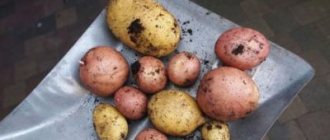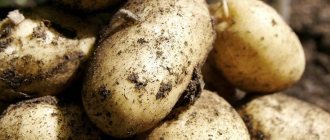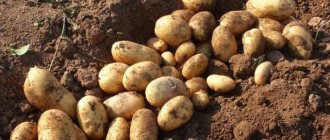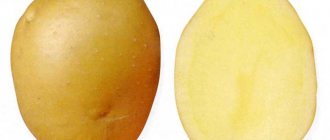Potatoes are quite demanding when it comes to storage conditions. We will tell you what conditions it needs to last for as long as possible without losing its taste properties. Only if you follow them will you be able to save the harvest until next year.
It should be said right away that not all varieties of potatoes are suitable for long-term storage. For example, early potatoes are recommended to be eaten during the fall; Medium-ripening varieties can sit a little longer - and no matter how hard you try, after a few months their tubers will still begin to sprout. And only late varieties of potatoes (if all conditions are met!) do not lose their quality for many months and can be stored until summer.
- TOP 7 largest potato varieties
Do you value potatoes primarily for their large tubers and high yield? Write down a list of suitable varieties!
Rule 1. Potato harvesting
However, not only the variety affects the keeping quality of potatoes. Another important condition for long-term storage is the correct and timely harvesting of the second bread.
When harvested in damp, rainy weather, the tubers will become saturated with moisture and will begin to rot during storage. If harvesting takes place in hot weather, the potatoes will quickly begin to sprout new shoots and dry out.
If harvested too early, the potatoes may not have time to ripen and therefore will also be poorly stored. The degree of potato maturity is determined by the tuber: if its skin is thin and peels off when rubbed with a finger, then it is too early to harvest. Ripe potatoes have a thick skin, the leaves have turned yellow, and the bushes have begun to dry out.
Harvesting of late varieties in the middle zone begins in late August - early September. 1-2 weeks before digging potatoes, mow down the tops, leaving stems about 10 cm high.
It is advisable to choose a dry, warm day for cleaning. To reduce injury to the tubers, it is better to dig potatoes with a pitchfork rather than a shovel.
After harvesting, leave the potatoes in the shade for 1-2 hours. During this time, the soil on the tubers will have time to dry and will be easy to clean.
- When to dig potatoes, or How to determine that potatoes are already ripe
August has arrived, and with it the period of potato ripening. But are your plantings ready for harvest or should you wait a little longer?
Arrangement of a basement or cellar for potatoes
Regardless of how the cellar or basement is built, where storage for vegetables and home-canned food is installed, the following conditions must be observed:
Purity. There is no clutter, accumulation of garbage, or the presence of rodents or insects in the room.
Fire safety. Storage of gasoline or other flammable and explosive liquids is prohibited.
Waterproofing – to protect against flooding, dampness, and the growth of mold and pathogenic fungi.
Ventilation – to maintain the microclimate in the room. Root crops stored in storage breathe and emit carbon dioxide; they need a constant flow of air. Contamination with both carbon dioxide and swamp gas penetrating through the walls is dangerous. In large quantities (from 10%) both are harmful to health.
To check whether there is enough oxygen in the cellar, light a match. If it does not burn, you should urgently ventilate the room: open the door and turn on the fan.
Thermal insulation is a necessary condition for maintaining a constant indoor air temperature. Suitable storage conditions for potatoes: temperature +2–5°C, relative humidity within 80–95%.
Lighting – in the cellar and basement it is unacceptable to use open fire (candles, kerosene lamps). It is necessary to install electricity, install a ceiling lamp and make a switch at a height of at least 1.5 m from the floor.
Monitoring instruments - It is useful to install a thermometer or psychrometer to know the temperature and relative humidity.
Safety. It is not advisable to go down into the cellar one at a time. If the room is cramped, then it is necessary for someone to stay outside and come to the rescue if necessary.
If the relative humidity in the cellar has become more than 95%, you need to install a box with dry sawdust or coarse salt in the room, which absorb excess moisture. The contents of the box are dried outside from time to time.
Too dry air is moistened using a box of wet sand or hanging pieces of cloth moistened with water.
In the cellar it is advisable to arrange metal or wooden shelving (assembled with bolts). They are periodically treated with antifungal agents. Metal shelving is painted with enamel to protect it from corrosion.
Approximate dimensions of the rack:
- shelf length – no more than 1 m;
- depth – 50–60 cm;
- board thickness – at least 30 mm;
- distance between shelves – 50–60 cm;
- the bottom shelf is not lower than 20 cm from the floor level;
- the top shelf at a distance of at least 50 cm from the ceiling.
Rule 2. Preparing potatoes for storage
Remove the crop, cleared of soil, into a dark, dry room with a temperature of 12-18°C (for example, a barn or garage) and leave it there for 2-3 weeks. During this time, the potatoes will dry completely and have time to finally ripen. Its peel will become dense and strong, which is necessary to protect the tubers from diseases. All wounds and microcracks that appeared during harvesting and transportation of potatoes will be healed.
In addition, during this period, all the problems of the grown crop, including diseases, will have time to appear. Problem potatoes should be immediately separated from the rest and either used for quick consumption or thrown away.
How to properly store potatoes in winter: expert advice
The gardening season is coming to an end. Many Tomsk residents have already managed to dig up potatoes, but how can they preserve the harvest until spring? Today we publish advice from specialists from the Agrarian Center of the Tomsk Region.
It is better to place the dug up potatoes under a shed (barn, garage) and dry them for several days. During this time, small injured areas will heal, the peel will become stronger, and diseased and rotting tubers can be easily selected.
Then you need to sort the potatoes into large (they need to be used for food first, since voids often appear during storage that can rot), medium and small. If desired, you can treat the tubers so that they do not rot, for example, with the drug “Kagatnik”.
Before putting potatoes into storage, it is better to disinfect the storage itself and containers with a 3% solution of copper sulfate, dry the cellar, and check the ventilation.
How to store potatoes in the cellar?
It is best to store potatoes in a basement or cellar. A cool, dark room inhibits the production of solanine, a substance that is toxic to humans. Green potatoes contain large amounts of solanine, so they should not be eaten. So, during storage, you need to observe the light and heat conditions so that the potatoes do not turn green.
Before storing potatoes, clean the cellar, check the condition of the hood, dry and whitewash the storage. The temperature in the basement or cellar should be 2-3 degrees with a humidity of about 80%. If the temperature is below 2 degrees, the potatoes will freeze and become sweet, and if the temperature rises above 3 degrees, the potatoes will begin to sprout.
What is the best way to store potatoes?
Wooden boxes or bins that allow air to pass through allow you to properly store potatoes in winter. It is advisable to place the boxes on a small stand. When storing potatoes in bins, fill them no higher than 1.5 meters. To prevent potatoes from sprouting, it is recommended to put several apples in the box. After the potatoes are placed in the bins, cover them with burlap or an old blanket to protect the top layer of potatoes from freezing. A couple of times during the winter it is necessary to sort through the potatoes and remove rotten and frozen tubers. Potatoes harvested in the fall can be stored in the cellar for 8-10 months.
Storage in the apartment
If you live in an apartment and do not have a cellar, you can store potatoes on the balcony. You will need a strong, airtight container, such as a box. It should include no more than 320 kilograms. To ensure that the box performs its functions properly, install a second bottom and make a double lid. Fill the voids with polystyrene foam, insulation or sawdust. It is better to make the box itself from clapboard or thick plywood. Paint the box to improve moisture resistance. To maintain the same temperature inside the box, install two 15-watt lamps inside. You can attach a thermometer to the wall of the box and turn on the light bulbs manually when the temperature drops. It is worth noting that under the influence of light, the potatoes in the boxes begin to turn green. To prevent this from happening, first cover the potatoes with a dark cloth or paint the lamps with dark paint.
If there is no balcony, then you can store potatoes in the winter in an apartment in any dark place.
How to choose the right potatoes so that they are tasty and can be stored for a long time: advice to Tomsk residents from experts. However, the shelf life in this case will be only one month. After this, the potatoes will begin to wither or grow.
You can also store potatoes for some time in the lower section of the refrigerator intended for storing vegetables. At the same time, it is better to keep the tubers in paper bags; potatoes begin to rot in plastic bags. But it should be borne in mind that when stored in the cold for a long time, sugar is formed from starch in potatoes and the tubers become sweet.
Can potatoes be stored with other vegetables?
It is possible, but not with everyone. Ideally, potatoes are stored with beets, which are placed on top of the tubers. Beets perfectly absorb excess moisture, which only benefits it, thereby protecting potato tubers from rotting.
Do I need to sort potatoes during the winter?
There is an opinion that by putting potatoes into storage, we only harm them - we unwittingly damage the tubers and mix sick ones with healthy ones. This
Queen of the table: what to cook from potatoes. Unusual recipes are a misconception. In winter, it is simply necessary to sort through potatoes, as various infectious diseases can manifest themselves in them. When sorting through potatoes, you need to remove from storage not only rotten tubers, but also all those that come into contact with them. If only healthy tubers lie on the surface, but an unpleasant odor emanates from the container, and small flies - fruit flies - appear in the room, these are also signs of rot. Such potatoes must be sorted all over, removing infected tubers.
Folk tips for extending the shelf life of potatoes
- Plants that secrete phytoncides help preserve potatoes longer. Tubers can be arranged with fresh rowan leaves, pine or spruce branches;
- Half an apple, placed in a box with tubers in the spring, will prevent potato germination by absorbing moisture;
- Mint delays potato germination. You can simply transfer the tubers with it;
- Potatoes will be stored better if you cover them with onion peels (it is recommended to sprinkle them in all boxes with potatoes).
Rule 3. Sorting the harvested crop
Before sending for storage, the harvested crop should be carefully sorted.
- First, separate the seed potatoes from the rest of the crop. Store it separately from the one intended for consumption.
- Then divide the remaining potatoes by size, keeping large tubers separate from medium ones. Try to eat large potatoes first, because... it is more susceptible to damage than others.
For long-term storage, leave the tubers:
- no signs of mechanical damage,
- with a thick skin,
- hard,
- unsprouted,
- without stains, with a clean smooth surface.
Holes and grooves on the surface of the tubers indicate that the crop has been “tasted” by insect pests. For example, small holes in potatoes are left by wireworms, and deep grooves are traces of the activity of the cockchafer larvae.
To further protect potatoes from spoilage during storage (and this often happens if the storage is too humid or the temperature often “jumps”), they should be processed. As a protective agent, you can use biofungicides - drugs to protect against fungal diseases, for example Fitosporin or Baktofit. You can also treat the crop with a solution of copper sulfate: dissolve 2 g of the drug in 10 liters of water. Another good remedy for protecting the potato harvest is herbal infusion. To prepare it, pour 1.5 kg of honey, 3.5 kg of wormwood and 750 g of tobacco leaves into 10 liters of water and leave for 24 hours. After this, strain the solution and spray the potatoes with it.
After treatment with any of the products, the potatoes should be thoroughly dried and only then sent for storage.
Preparing the cellar
Before storing root crops for the winter, the cellar must be prepared - get rid of insect pests, fungal spores and rot. About a month before harvesting, the cellar is disinfected.
- Brick walls and ceilings are whitened with a lime solution (2.5 kg per 1 bucket of water) with the addition of 50 g of copper sulfate. Vitriol can be replaced with factory-produced anti-mold preparations.
- Wooden surfaces (partitions, shelves, drawers) are treated with a spray bottle with a saturated solution of pharmaceutical potassium permanganate or vitriol (100-150 g per 1 liter of water).
- The earthen floor is sprinkled with fluff lime in a 1 cm layer.
- Use a blowtorch to burn out mold colonies in the corners.
- Seal all cracks and passages of rodents with cement mortar.
- Clean the ventilation duct and cover it with a metal mesh.
- Following the instructions, fumigate with a “Climate” sulfur bomb.
Not earlier than 2 days after treatment, ventilate the cellar well.
And to prevent the cellar from flooding, you need to use high-quality materials, such as Corsis 110 pipes on the website ingplast.ru, with it there will certainly be no leaks.
Rule 4. Optimal storage temperature for potatoes
It is difficult to answer unequivocally what temperature is needed for long-term storage of potatoes, because... There are varieties with special storage conditions. However, most types of second bread are best stored at a temperature of 2-4°C.
At a lower temperature, starch begins to break down into sugars and the potatoes acquire a sweet taste. At higher temperatures, the tubers begin to wither and shoots grow rapidly.
This temperature must be maintained throughout the entire period of natural dormancy, i.e. until about the end of March. Then the potatoes begin to grow. To prevent this from happening, it is recommended to reduce the temperature to 1°C. In this case, the potato harvest can be preserved until summer without loss of quality.
Can potatoes be stored in the refrigerator?
The rules for storing peeled potatoes are different: the potato peel has protective properties and when separated from the fruit, the shelf life of the potato is significantly reduced. Can potatoes be stored in the refrigerator? Yes, peeled root vegetables must be stored in the refrigerator or other cold place at temperatures up to 2-4 degrees. The storage container must be airtight and tightly closed, and the peeled potatoes must be dried. In such conditions, the fruits will be stored for a couple of hours, after which oxidative processes will begin and the potatoes will darken.
How to store peeled potatoes?
In order to extend the life of peeled potatoes, it is recommended to store the vegetable completely immersed in cold fresh water in a closed container. Thanks to immersion in liquid, dark spots will begin to appear within a day. How to store peeled potatoes, since they are already a semi-finished food product and are not suitable for long-term storage? After 3-4 hours of soaking in water, the potatoes will begin to lose water-soluble vitamins, which will affect not only the usefulness of the product, but also the taste.
The best way is to store peeled potatoes in airtight boxes or plastic bags in the freezer. This option will provide longer storage.
Attention! During long-term storage, the taste may change
Rule 6. Lighting
The potato storage should always be dark. Light is the friend of growing potatoes, but the enemy of stored potatoes. When sunlight hits the tubers, they begin to produce a poison called solanine. In this way, nature protects potatoes from pests and diseases: green tubers avoid these misfortunes.
However, solanine is dangerous not only for insects, but also for humans. It can cause poisoning and lead to health problems. For this reason, green tubers cannot be eaten - they are recommended to be used only as planting material.
Common Mistakes
The most common causes of potato spoilage during storage are:
- Storing tubers of different sizes in storage (small potatoes spoil faster).
- Washing tubers.
- Neglecting to clear the cellar of debris.
- Burning a sulfur bomb after loading the cellar with potatoes (sulfur vapors cause damage to root crops).
- Keeping potatoes and apples in the same basement (fruits emit ethylene gas, which contributes to the rapid overripening and spoilage of vegetables).
- Changes in temperature and humidity in the room.
In winter, free-standing cellars are additionally insulated with snow. The potatoes inside the storage facility are covered with hay, straw, and blankets.
Rule 7. Potato storage containers
Potato storage containers can be made of various materials: wood, fabric, plastic, etc. Most often, potatoes are stored in wooden or plastic boxes, canvas bags, synthetic nets or wicker baskets. The main condition is that containers for storing potatoes must have holes for ventilation through which air flows freely pass. In tightly sealed containers, where there is no air movement, moisture accumulates and the tubers begin to rot. For this reason, plastic or cellophane bags are not suitable for long-term storage of potatoes.
How to prepare the room?
It’s worth starting preparations in the summer. First, open the cellar and dry it well. Since the cellar freezes very much in winter, it is worth insulating it in order to obtain an acceptable temperature for storing potatoes.
It is necessary to sheathe a wall that is located above the freezing level of the soil with sheets of foam plastic. Such sheets are secured with glue or foam. The roof must be made of wood, the edges must be insulated.
In this case, frost will not penetrate the walls of the cellar.
Rule 8. Preparing storage for storing potatoes
For normal preservation of potatoes over a long period of time, special storage facilities are best suited. They should be dry, warm and cool. However, even in such ideal places, the potato harvest can be spoiled. The main danger of stored crops is rodents.
- Before storing potatoes, carefully inspect the entire room to find places through which mice and rats can enter the storage, and seal all cracks.
- Install metal grilles on ventilation hatches.
- Place dried herbs on the floor, the aroma of which repels rodents: tansy, wormwood, mint.
- They also don’t like the smell of mothballs - place it next to the potatoes.
- If possible, place ultrasonic traps in the storage area.
- 10 ideas on how to get rid of mice in a country house (only proven means!)
Rodent control methods that will make them capitulate.
Preparing the premises for potato storage also includes disinfection. The most effective way is to use sulfur bombs. However, when using them you need to be very careful not to harm your own health.
If there is a high level of humidity in the room where potatoes are stored, place containers with quicklime, charcoal or regular table salt. All these fillers absorb excess moisture well, but they will need to be replaced with new ones from time to time.
And, of course, do not forget about ventilation and regular airing of the storage.
- How to prepare a cellar for harvest storage
Soon we will begin to consume what we worked so hard to grow all spring, summer and autumn. But how to preserve the harvest? We need to think about this now.
Choosing a storage place
There are several proven options for storing potatoes on a balcony during the winter months, but not all of them allow you to preserve vegetables during frosts. These are the following methods:
- use a box with sawdust;
- cover the bags of potatoes with an old blanket;
- put in plastic containers;
- make an insulated box from wood;
- use a heating cabinet or a ready-made thermal container;
- use an old refrigerator;
- make a container with ventilation;
- make a chamber with heating.
When choosing a storage location, you should consider 2 rules:
- the potato box should not interfere with the free movement of residents on the balcony;
- It is better to place it away from the cold external wall.
To minimize potato losses over the winter, it is recommended to use the advice of experienced gardeners:
- vegetables for winter storage are collected only in dry weather; for better preservation they should be pre-dried, preferably in the open air;
- Before storing, potatoes should be sorted and sorted by quality, separating damaged and diseased tubers from healthy ones, and store them separately;
- before the start of the season, boxes and storage containers should be disinfected with a mixture of soap, soda and hot water, after drying - treated with copper sulfate (proportions - 100 g per 1 bucket of water) and lime;
- To reduce the likelihood of rotting, it is recommended to sprinkle the tubers with chopped garlic or layer them with rowan leaves.
Rule 9. Shared storage of vegetables
Of the many vegetables, only beets are suitable for potatoes as a neighbor. This root crop needs moisture for long-term storage, but for the potato harvest, as mentioned above, excessive moisture is detrimental. The beets are simply poured in several layers onto the potatoes. During storage, root vegetables absorb the moisture that appears on the tubers - thus, joint storage benefits both types of vegetables.
Some summer residents use a more complex method - layer-by-layer storage of beets and second bread. A layer of beets is placed on a layer of potatoes, then more potatoes are poured on it, and beets again, etc.
Keeping potato varieties
The keeping quality of potatoes largely depends on its variety. The types of vegetables that belong to the group of mid-late and late varieties are best stored.
The following varieties are characterized by the ability for long-term storage:
- Gull;
- Crane;
- Slav;
- Saturn;
- Asterix;
- Scarlett;
- Nevsky;
- Kolobok;
- Bernadette;
- Blue;
- Tatchinsky;
- Yavir.
Any, even the most shelf-stable variety of potato, needs certain storage conditions, otherwise rotting of the tubers and deterioration in their quality characteristics cannot be avoided.
Vegetables that grew on light soils with a significant admixture of sand last much longer than those grown on low-lying lands with a predominance of clay.
Rule 10. Regular removal of spoiled tubers
Even if you followed all the rules described above and placed the potatoes for storage in the ideal place, they can still deteriorate during storage. To detect spoiled tubers in time, inspect the stored crop at least once a month and remove specimens with signs of spoilage. Remember: just one rotten potato can lead to the loss of a large amount of harvest if it is not separated from healthy tubers in time.
- Why potatoes rot in the cellar - 6 most dangerous diseases
Do you dream of eating potato pancakes and potato dumplings with meat all winter? Then immediately get on the warpath against dangerous potato diseases.
Growing a potato crop is not an easy task. However, maintaining it is no less difficult. We hope our tips will help you with this.
- How to properly store potatoes in a house or apartment
Is it possible to save the potato harvest until spring? Only if you choose a suitable location and microclimate.
Storage methods in the cellar
So, the potato tubers and the room are prepared for long-term storage; it’s time to choose in what form they will be in the cellar. There are several options: store vegetables in boxes, in bags, in nets, in closed containers, or simply in bulk. Let's look at each storage method.
In wooden boxes
It is convenient and correct when potato storage boxes are placed on racks or pallets. Two drawers are placed on a shelf; they are not placed close to each other, but keeping a certain distance: 5 cm between the drawers and 3 cm from the wall.
Coniferous wood is more suitable for boxes; the distance between the slats is approximately 4 cm.
In natural fabric bags
Most often, potatoes are stored in canvas bags. This method allows the tubers to breathe, not get overcooled and not become damp. There should be a distance of 5-10 cm between the bags. The bags are also placed on pallets.
In bulk
You can store potatoes simply by scattering them on trays. But in this case, fruit rotting is possible due to poor air exchange.
In grids
Potato tubers are often stored in nets, which are again placed on pallets. However, in this case, the nets with potatoes must be covered on top with a layer of straw or old jackets so that the tubers do not freeze.
The best varieties for long-term storage
In order to obtain an early harvest, the gardener chooses early-ripening varieties for planting, but they are completely unsuitable for long-term storage and quickly deteriorate even in an ideally equipped storage facility.
Potato varieties with medium or late ripening periods are best stored in the cellar. At the same time, the fruits do not lose their attractive appearance and retain their good taste until spring.
The best varieties suitable for winter storage include:
- Picasso. The variety holds the record for shelf life. The tubers are oval in shape and have a smooth beige skin. The weight of one fruit can reach 100 g. The fruits have an excellent taste and contain a minimum of starch.
- Asterix. Potatoes of this variety have an oblong shape and are covered with a red skin. The tuber pulp contains about 16% starch and has a good taste. The weight of one fruit is about 100 g.
- Atlant. This variety was bred in Belarus and is perfectly stored in the cellar until spring. The fruits are round, with a light brown skin, and contain 18–20% starch. The pulp of the tubers is very tasty and does not darken in the air.
- Stonefly. The fruits of this variety are round and not very large. The peel has a pink tint, and the pulp contains 20% starch. The pulp of the tubers is cream-colored and has a good taste.
- Scarlett. The variety is early, but in a well-equipped cellar it can be stored until the end of February. The tubers are oval, their weight is 100–150 g. The skin of the fruit is smooth and red. The pulp is grainy and tasty, containing 16% starch.











